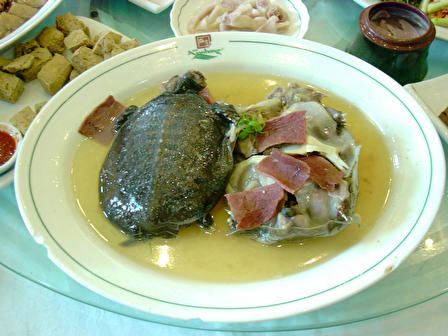Disgusting Food: The Sport of Eating

I’d told my friends that my favorite local Japanese place served something provocative.
“We’ve got to try it!” they exclaimed, to my horror.
Among the unfamiliar Japanese characters and random pornographic drawings on the menu, I managed to find what we — or at least they — wanted. It was clearly labeled in English:
“BULL’S PENIS…$5.50.”
We asked our waitress if it was good. She smiled politely and laughed, but didn’t answer.
It came covered in miso paste, looking boiled or steamed. It lacked any shape, so I couldn’t even imagine what it looked like before it hit the pan. We poked and prodded. It moved like rubber, and looked like a mass of cartilage. And finally I saw it—a hole. This was definitely not a donut.
We divided the penis into three. After covering mine in more miso, I stuffed the whole thing into my mouth and proceeded to chew…and chew. The texture was rubbery. The only thing my taste buds captured was the sawdust-like aftertaste.
Get the world’s most fascinating discoveries delivered straight to your inbox.
But my friends seemed to be enjoying themselves. I realized that eating grotesque, weird food was like a sport for them — a hobby.
They have plenty of company, I discovered — extreme epicureans breaking social food norms with their odd menu choices. And they aren’t necessarily in it for a great meal.
“It’s fun. It’s like a challenge,” explained my friend Jason. He said he’d eaten live, or “drunken” shrimp, a few months earlier.
One blog calls such experiences “deep-end dining.” Deependdining.com says it is “dedicated to seeking and devouring the food uncommon, the cuisine exotic and the entrees less ordered.”
“Part of the appeal of eating such weird foods is the fear, the challenge and the unknown,” said Eddie Lin, the Los Angeles food writer who created deependdining.com.
Sometimes revulsion stems from cultural disconnect. Many Chinese grow up eating dishes like hundred year old egg, or shark fin. Some Filipinos eat balut — a duck egg with a fetus inside, and certain Koreans like to eat water bugs. In parts of the U.S. south, large rodents are considered a homemade delicacy.
Lin’s inclination to bizarre eats began when he was six, and his mother, who emigrated from mainland China, placed a pig’s brain, her favorite dish, in front of him and his younger brother. They were not to leave the table until they finished it.
“My mother always hated to waste food. As a new immigrant she didn’t want us to lose sight of how good we had it,” explained Lin, who said he was forever changed by this incident. “From that point on nothing is too weird for me. I kind of started liking things that were outside the norm.”
Lin finds bizarre foods by scouring newspapers, blogs and magazines, or by word of mouth. Yet he’s not excited by the prospect of these excursions — he says he’s “very worried, scared and concerned.”
“I just pray that I don’t get sick or die,” he said.
He ate live octopus and almost choked, when the live tentacle suctioned to his tonsils.
In Mexico, he ate huitlaoche—diseased corn smut.
Most of the food he consumes isn’t appetizing, even to him. The Korean silkwood pods he ate “tasted and smelled like a cockroach infested apartment.”
Why eat such things, then?
“I really care about the experience and food anthropology — where it’s from, why people eat it, what other people think about it,” said Lin, whose blog has been featured in a 2005 best food writing anthology. “I really try to cover every angle of it. It’s not just stunt journalism.”
But recklessness, experimentation and a feeling of pushing against limits are also hallmarks of the breed.
“If it’s there I won’t say no,” admitted native New Yorker Stephanie Lau, 25. “I’m really open-minded and I want to try everything.” Lau likes to explore and travel, and says she doesn’t want to limit herself in any way.
Her most interesting dining experience took place in a small Vietnam village, nicknamed “Snake Village.”
“First they [waiters] bring the snakes out and they slit them all the way down while they’re alive,” she explained to me one day over dinner. “They squeeze out all the blood and pour it into shot glasses mixed with a tiny bit of rice wine. They cut out the still-beating hearts and leave them on a small plate, and then the gall bladders on another plate. We dropped the hearts in the shots of blood and drank. Next we dropped the gall bladders in shots of rice wine and drank. The snakes were taken in to the kitchen and used to prepare our meal.”
Others might feel queasy, but Lau said the ritual excited her. “[I] enjoyed the spectacle of the snakes being sliced open,” she confessed.
This article is provided by Scienceline, a project of New York University's Science, Health and Environmental Reporting Program.
- Good Food Gone Bad
- Top 10 Aphrodisiacs
- Will Eating Pet Food Kill Me?


